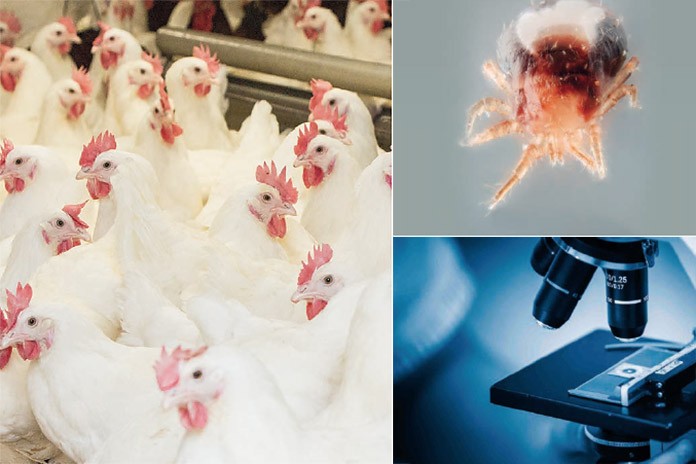
The use of DNA barcoding can facilitate rapid biodiversity assessments of fastidious taxa – litter mite communities – by delineating species using molecular operational taxonomic units (MOTU’s).
The following is a case study where this approach was used to assess the community structure of terrestrial mites across several substrate and habitat types in subarctic Canada. A standardized sampling program was implemented, where mite communities were sampled in ten localities from seven substrates; moss, soil, litter, woody debris and lichens (Cladina spp., Peltigera leucophlebia, Parmelia/Hypogymnia). Approximately 500 mL of material from each substrate was collected, and extracted using modified Berlese funnels into 95% ethanol (EtOH). As well, two transects of five pitfall traps (with 95% EtOH) were deployed at each site and visited every 3 days over a total period of 9 days.
The specimens in each sample were sorted into morpho species, and up to five specimens of each were selected for sequence analysis. These specimens were identified to a family level, and oribatid mites were identified to genus. Each specimen was photographed and subsequently placed in a well containing 50 µl of 95% EtOH in a 96 well microplate.
Collection details for each specimen together with its taxonomic assignment and its photograph are linked in the Barcode of Life Datasystems (BOLD www.boldsystems.org). All subsequent laboratory analyses were performed at the Canadian Centre for DNA Barcoding (CCDB – www.ccdb.ca)
Tissue lysis was performed on the whole specimen, and an automated, silica membrane-based DNA extraction protocol was performed using 3 µm glass fibre filter plates, coupled with 0.45 µm glass fibre plates as an additional step to recover the specimen vouchers. DNA amplification and sequencing reactions were performed following standard protocols (http://ccdb.ca/resources.php) using a cocktail of LepF1/LepRI and LCO1490/HCO2198 primers. Failed amplification reactions were further processed using the MLepF1 and MLepR2 primers.
DNA extracts were placed in archival storage at -80° at the Biodiversity Institute of Ontario. Vouchered specimens were stored in 95% EtOH or slide mounted in Canada balsam, and deposited at both the Biodiversity Institute and the Canadian National Collection of Insects, Arachnids and Nematodes. Contigs were assembled and edited using CodonCode Aligner v. 3.0.1, and aligned in MEGA 5.03.
Each sequence with a length greater than 500 base pairs (bp), less than 1% ambiguous sites (Ns), and lacking stop codons was assigned a Barcode Index Number (BIN) by BOLD (Ratnasingham and Hebert 2013). Because BINs are highly congruent with biological species (Ratnasingham and Hebert 2013), they allow for global comparison of specimens lacking species designations using a transparent and reproducible method.
In total 8240 specimens (approximately 14% of the total catch) were selected for analysis. Barcode sequences were recovered from 6365 specimens with an overall sequencing success rate of 77.2%. However, taxonomic bias in sequence recovery was detected, with a high of 80.4% in Sarcoptiformes and a low of 68.2% in Trombidiformes; this is likely a reflection of primer binding. These sequences represented 899 BINs.
Using BINs allowed us to assess various aspects of the diversity of mites, including the completeness of sampling, species richness, and faunal similarity between mite communities in several substrates and sites. In a relatively short time frame we were able to document almost three times as many species in subarctic Canada than previous surveys conducted using traditional morphological identifications. This framework facilitates rapid and detailed assessment of mite communities in any geographic setting, such as characterizing beneficial mite communities associated with healthy poultry farms absent of Poultry Red Mite infestations.
This study serves as the foundation for a DNA barcode reference library of mites. Traditionally, DNA barcode reference libraries are assembled by sampling local fauna from museum collections that have been expertly identified by taxonomists. However, museum collections of mites are often slide mounted, or stored in non-DNA friendly fluid, to facilitate morphological identification. With this non-destructive method in which DNA is extracted prior to detailed morphological assessment, the voucher specimens remain a valuable resource for future taxonomic research, particularly since specimens are already partitioned into MOTU’s and can be easily retrieved for morphological study. As the DNA barcode reference library of mite progresses, an increasing proportion of specimens can be assigned to family, genus, and even species by their BIN identity. Ultimately, litter mite communities in poultry farms can be characterized by high-throughput DNA barcoding methods in the absence of species identifications. Once baselines are determined for various community structures, future analysis could see rapid assessments of bulk samples by way of Next Generation sequencing technologies.
References available on request
From the First Cost Conference and Management Committee Meeting
















